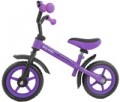Wheel diameter
Bicycle wheel diameter is traditionally indicated in ". The overall height of the bike directly depends on this parameter, so each age category has its own wheel size - in accordance with the height of the young cyclist. However, cars of the same type and age group may differ in wheel diameter; this is especially pronounced among two-wheeled bicycles. In such cases, it is worth considering the following point: larger wheels behave better on rough roads and allow you to coast for a long time, but they are reluctant to accelerate and require more effort on the pedals; small wheels - on the contrary, they spin without much effort, but they hold speed worse and are more sensitive to pits and potholes.
Tricycles predominantly have a wheel diameter of
10 ", balance bikes -
12 ". In two-wheeled models, there are sizes in
14,
16,
18 and
20 ". Larger diameter wheels are no longer used in children's, but in teenage bicycles (they are listed in our catalog in the section with older bikes).
Cast wheels
In the context of children's bicycles,
alloy wheels refer to monolithic wheels made by injection molding. This is where they differ from traditional wheels, where the rim and hub are connected by spokes. Alloy wheels are typically stronger and more resistant to damage, and with fewer moving parts, they are easier to maintain.
Country of origin
The country of origin of the brand under which the product is marketed. Often indicated by the nationality of the company or the location of its headquarters. At the same time, the actual production capacity of the brand often differs from the country of origin.
It should be noted that the quality of products depends not so much on geography, but on the peculiarities of the organization of processes and quality control at all stages of production. Therefore, national prejudices regarding brands from certain regions, as a rule, are not supported by anything. It is necessary to pay attention to the country of origin of the brand only if the task is to fundamentally support or bypass the manufacturer from a particular state.

